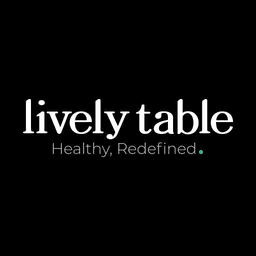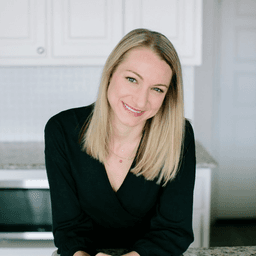How Kaleigh McMordie Turned a Food Blog Into a Six-Figure Asset While Raising a Family


Business Description
Table of Contents
Navigate through the case study sections
Executive Summary
Case Study Content
How Kaleigh McMordie Turned a Food Blog Into a Six-Figure Asset While Raising a Family

From Dietician Student To Food Blogger
Kaleigh McMordie didn’t dread Mondays, because she never wanted a traditional job in healthcare. While working on her graduate degree in dietetics in 2015, she knew the 9-to-5 hospital grind wasn’t for her. So instead of another internship or shift at the hospital, Kaleigh took a chance: she merged her nutrition knowledge and passion for home cooking into what would become Lively Table.
Starting a blog isn’t exactly easy, ask most creators, and they’ll tell you the early days are lonely and confusing. For Kaleigh, every meal seemed a potential blog post, but the reality was painfully slow traffic and little feedback. She describes that first year as a total learning curve: “I had no idea what I was doing… I spent all my extra time working on the blog and Googling how to do things since I didn’t have the money to pay someone to do things for me.”
The First Dollar Is The Hardest
Every founder remembers their first sale or payday, and for Kaleigh, it was a $100 sponsored post, a reward for a year’s worth of late-night recipe testing and amateur photography. The payout was modest but proved blogging could be more than an online journal. The real shift happened when she landed her first virtual assistant job working for another food blogger. That role opened her eyes to what actually brings traffic: smart promotion, building connections, and being strategic with content rather than simply hitting “publish.”
Early Strategy: Community and Consistency
Kaleigh realized she couldn’t thrive in a vacuum. She started connecting with other bloggers, shared her work across social media, even when algorithms made doing so frustrating, and committed to a posting routine. She meticulously tested each recipe before sharing. Investing time in learning photography turned plain homemade meals into thumb-stopping content, driving the audience’s trust.
Breakthrough: SEO and Earning Real Income
After about two years, it all started compounding. Lively Table jumped to roughly 50,000 monthly visitors in its second year. This win wasn’t an accident: Kaleigh pivoted to prioritize SEO, researched seasonal trends, and focused on content people actually searched for. Landing a spot on Mediavine’s ad network was a pivotal moment, nearly doubling her income overnight without the unreliable hunt for sponsored posts.
As the site grew, so did brand partnerships. By year three, sponsored posts and ad revenue each made up about half her income. This gave her the confidence to quit her remaining part-time work as a dietician, freeing up time to stay home with her newborn (and load-tested every recipe in a real family setting).
Scaling Without Burning Out
Running a content business around the clock isn’t sustainable. By 2021, burnout and social media fatigue crept in for Kaleigh. She found herself dreading the platforms that once brought growth. Having built a solid SEO foundation, her organic search traffic kept Lively Table thriving even as social visits plateaued. Kaleigh shifted her focus to streamlining the business, no more sponsored campaigns, only display advertising for passive income. That decision meant less juggling and fewer deadlines, but also fewer revenue streams.
Making The Exit: Selling For Over $200,000
Selling an online business sounds simple, but it’s rarely a straight line. Kaleigh didn’t even know blog sales were a thing until she heard a podcast about exiting content sites. She started with the wrong broker, who misunderstood the online food niche, and watching months go by without real offers. Eventually, she found a broker with experience who valued her site properly and handled the sale professionally. In 2022, Lively Table sold for over $200,000, about 35x the average monthly ad income at the time, all with Kaleigh working from home, raising two kids.
Her biggest lesson: the broker you choose can make or break your exit timeline. The wrong person wastes your time and can sap your confidence. By the end, Kaleigh admits she was so tired she would have accepted less, but persistence paid off. Most first-time sellers underestimate how draining the process is, especially emotionally.
Recipe For Success
- Testing every recipe, never sacrificing quality for quantity.
- Learning food photography basics to create visually appealing content.
- Posting consistently, an achievable schedule, not perfection.
- Doubling down on SEO for sustainable, compounding traffic.
- Networking with other bloggers and cross-promoting in the space.
- Knowing when to pivot, focusing on the income streams that fit her life stage.
Kaleigh’s experience isn't just about a big payout. Lively Table gave her the flexibility to stay home with her growing family, and the ability to choose projects that aligned with her evolving interests. The technical hurdles she overcame, WordPress struggles, learning SEO, shooting her own food photos, offered skills she now applies to new ventures.
What’s Next?
Post-sale, Kaleigh launched two more content sites aligned with her life: Baby Led Bliss and The Clean Beauty Review. She’s planning another food blog, and an aviation-focused project (Kaleigh and her husband are small-plane owners). The technical knowledge and creative processes honed on Lively Table still pay dividends in each new project.
Lessons For Future Content Entrepreneurs
- Posting regularly and investing in content quality matter more than overnight growth.
- You don’t need to be an expert at everything, Google is your friend, and you’ll make mistakes along the way.
- Choosing the right partners, especially for a sale, saves more than just money.
- Traffic sources change (social, SEO, direct), adapt or risk losing momentum.
- Passive income streams like display ads give more flexibility than high-touch brand deals.
- Most importantly, businesses grow best when they fit your life and values, not the other way around.
In Kaleigh's Words
"I gained so much technical knowledge...photography, writing a good recipe, marketing, communication and all that comes with running a content site. I was so lucky to have the freedom and flexibility to set my own schedule and stay home with my kids while they were babies. I learned a lot about myself and about building something from scratch, as well as what my values are and which ones I’m not willing to compromise on."
For anyone thinking of starting, scaling, or selling a blog, Lively Table’s story is a reminder that practical actions, networking, never skipping quality, and picking projects that match personal priorities, lead to real, life-changing results.
Key Takeaways
- 1Building a blog as a side project can generate a full-time income and eventual exit if paired with consistency, niche expertise, and smart SEO.
- 2Quality content, especially tested recipes and professional photography, can establish strong reader trust and help scale traffic.
- 3Networking with others in the niche opens doors, both for learning and cross-promotion, accelerating growth beyond organic search.
- 4Diversifying revenue streams (ad networks, sponsorships) creates financial stability, and learning when to refocus on the best-fit income sources is vital.
- 5Selling a content site is possible and lucrative, but working with the wrong broker can waste time and lower your exit value.
- 6Design your business to fit your life and values, Kaleigh grew Lively Table while making time for family, then used the skills and freedom to launch new passion projects.
Key Facts
Tools & Technologies Used
Premium Content Locked
Subscribe to access the tools and technologies used in this case study.
Unlock NowHow to Replicate This Success
Premium Content Locked
Subscribe to access the step-by-step replication guide for this case study.
Unlock NowInterested in Being Featured?
Share your success story with our community of entrepreneurs.
Explore More Case Studies
Discover other inspiring business success stories

How Brad Younger Sold IDA Connect for $470K and Fueled His Dream of Space Travel
Brad Younger built IDA Connect, a SaaS integration tool for ecommerce brands selling on The Iconic. Spotting a market ga...
IDA Connect

How Jon Payne Scored Two 7-Figure Exits with SEO and Amazon FBA
Jon Payne began experimenting with HTML and SEO in college, scaled his freelance gigs into a 15-person agency, and sold ...
Illuminated Goods

From IT Burnout to Blog Exit: How Steve Adcock Sold Think Save Retire for Six Figures
Steve Adcock, after 14 years in IT, started Think Save Retire to document his path to financial independence, never expe...
Think Save Retire